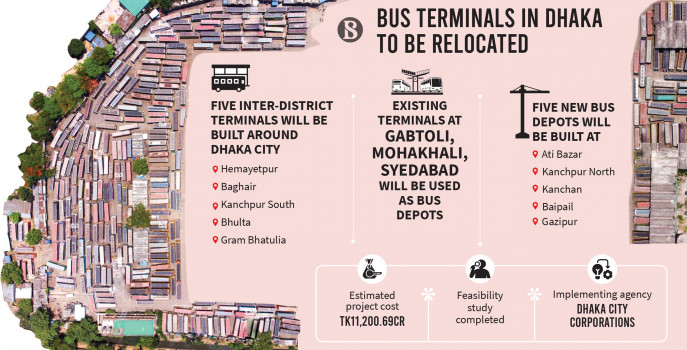Bilal9
ELITE MEMBER

- Joined
- Feb 4, 2014
- Messages
- 26,545
- Reaction score
- 9
- Country
- Location
The project, which will cost an estimated Tk11,200.69cr, is expected to ease traffic congestion
Infographic: TBS

Infographic: TBS
The feasibility study for shifting inter-district bus-terminals from the heart of the capital to its periphery, which aims to ease traffic congestion, has been completed.
The relocation project proposed the construction of five new terminals around Dhaka – at Hemayetpur, Baghair, Kanchpur South, Bhulta and Gram Bhatulia – and five new bus depots at Ati Bazar, Kanchpur North, Kanchan, Baipail and Gazipur.
Once the proposed terminals are built, the existing three bus terminals at Gabtoli, Mohakhali and Syedabad will be used as city bus depots to bring about discipline in operation.
The proposal outlines the need for new bus depots as the demand for night-time parking of city-buses cannot be accommodated at the three existing terminals.
Kanchpur North will be used both as inter-district terminal and city-bus depot while Baipail and Gazipur depots have been proposed for use as bus or truck depots.
The cost of the relocation project has been estimated at Tk11,200.69 crore.
The development of additional inter-district bus terminals at the periphery of the city was suggested in the Revised Strategic Transport Plan (RSTP) in order to improve accessibility and mobility.
As part of the plan, the Dhaka Transport Coordination Authority (DTCA) engaged the Infrastructure Investment Facilitation Company (IIFC), in March 2020 to carry out the feasibility study.
The IIFC, which is an enterprise of the Economic Relations Division under the Finance Ministry, completed the study in September last year.
"Now the relocation plan will be implemented through a project. Discussions are going on to arrange funds either under public-private-partnership (PPP) or on a government-to-government basis," said DTCA Executive Director Sabiha Parveen.
She also said that the technical committee of the bus-route rationalisation will discuss the progress at a meeting slated for 7 February.
"The Dhaka city Corporations will be the implementing agencies for the project. Their officials are already visiting the spots to determine necessary steps for land acquisition," said Sabiha Parveen, who is also member-secretary of the technical committee.
"Relocating the existing bus-terminal will reduce the number of vehicles and ease traffic," she said, adding that the terminals will have interconnectivity through ring roads and bypasses, so passengers can travel from different districts without passing through the capital.
Terminals with multimodal-transport facilities
The feasibility study proposed that the terminals have multimodal-transport facilities, including sufficient parking space for city-buses, taxis, auto‐rickshaws and private cars to transport passengers to and from the city.
It will also have adequate night-parking for inter-district-buses and dormitory facilities for bus crew for resting and night-stay.
Bus washing facilities and workshops on small repairs will be available in the new terminals. Furthermore, keeping future demand in mind, a facility for charging of electric vehicles has been proposed in the state-of-the-art terminals.
The main terminal buildings are proposed to be multi-storeyed, with buses to be parked on the ground floor while parking for cars and other vehicles have been recommended for the basement.
For passengers and visitors, the terminal will provide a spacious waiting-lounge, breastfeeding centre for mothers, a sufficient number of toilets, seating arrangements and prayer rooms for males and females. Facilities for disabled persons, the elderly, and physically challenged will also be available.
The terminals will be decorated with sculptures, paintings and other displays to reflect local and national heritage. They will have separate arrival and departure lounges for passengers and separate entry and exit points for buses.
CCTV cameras for security, WIFI facility, digital display of arrival and departure information and cashless terminal charges and e‐ticketing will be introduced there. Games for children, books and stationary shops, salons, ATM booths and restaurants will be available. The terminals will have escalators, elevators and staircase facilities.
Separate dormitory buildings with facilities, separate cafeteria, kitchen, and prayer space for the bus crew have been proposed.
Office space for different transport associations and terminal officials, lockers for the staff, monitoring and security rooms, adequate way-finding and information signal, and store rooms will be there.
Use of solar energy, higher reliance on natural lighting, waste and waste-water management, rain-water-harvesting and other important facilities will also be added.
To control water-logging, better drainage and solid waste management systems as well as ETP for discharging bus-wash-effluents are also in the plans.
Adequate fire-fighting systems, first aid and emergency services, parking space for at least one ambulance and one fire fighting vehicle has been kept at the terminals.

